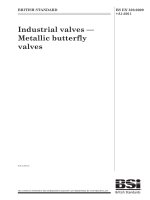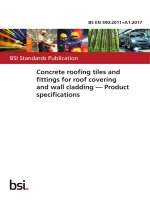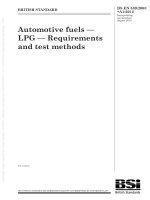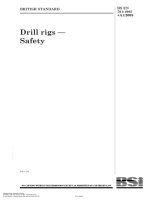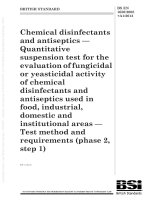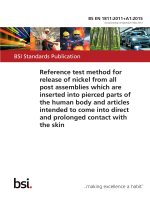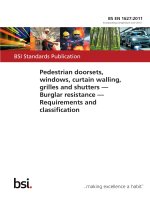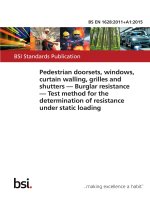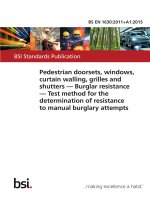Bsi bs en 15918 2011 + a1 2013
Bạn đang xem bản rút gọn của tài liệu. Xem và tải ngay bản đầy đủ của tài liệu tại đây (1.14 MB, 36 trang )
BS EN 15918:2011+A1:2013
BSI Standards Publication
Cycles — Cycle trailers — Safety
requirements and test methods
BS EN 15918:2011+A1:2013
BRITISH STANDARD
National foreword
This British Standard is the UK implementation of EN 15918:2011+A1:2013.
It supersedes BS EN 15918:2011, which is withdrawn.
The start and finish of text introduced or altered by amendment is
indicated in the text by tags. Tags indicating changes to CEN text carry
the number of the CEN amendment. For example, text altered by CEN
amendment A1 is indicated by
The UK participation in its preparation was entrusted to Technical
Committee GME/25, Cycles.
A list of organizations represented on this committee can be obtained
on request to its secretary.
This publication does not purport to include all the necessary provisions
of a contract. Users are responsible for its correct application.
© The British Standards Institution 2013.
Published by BSI Standards Limited 2013
ISBN 978 0 580 79015 7
ICS 43.150
Compliance with a British Standard cannot confer immunity from
legal obligations.
This British Standard was published under the authority of the Standards
Policy and Strategy Committee on 30 September 2011.
Amendments/corrigenda issued since publication
Date
Text affected
31 May 2013
Implementation of CEN amendment A1:2013
EUROPEAN STANDARD
EN 15918:2011+A1
NORME EUROPÉENNE
EUROPÄISCHE NORM
January 2013
ICS 43.150
Supersedes EN 15918:2011
English Version
Cycles - Cycle trailers - Safety requirements and test methods
Cycles - Remorques pour cycles - Exigences de sécurité et
méthodes d'essai
Fahrräder - Fahrradanhänger - Sicherheitstechnische
Anforderungen und Prüfverfahren
This European Standard was approved by CEN on 18 June 2011 and includes Amendment 1 approved by CEN on 20 November 2012.
CEN members are bound to comply with the CEN/CENELEC Internal Regulations which stipulate the conditions for giving this European
Standard the status of a national standard without any alteration. Up-to-date lists and bibliographical references concerning such national
standards may be obtained on application to the CEN-CENELEC Management Centre or to any CEN member.
This European Standard exists in three official versions (English, French, German). A version in any other language made by translation
under the responsibility of a CEN member into its own language and notified to the CEN-CENELEC Management Centre has the same
status as the official versions.
CEN members are the national standards bodies of Austria, Belgium, Bulgaria, Croatia, Cyprus, Czech Republic, Denmark, Estonia,
Finland, Former Yugoslav Republic of Macedonia, France, Germany, Greece, Hungary, Iceland, Ireland, Italy, Latvia, Lithuania,
Luxembourg, Malta, Netherlands, Norway, Poland, Portugal, Romania, Slovakia, Slovenia, Spain, Sweden, Switzerland, Turkey and United
Kingdom.
EUROPEAN COMMITTEE FOR STANDARDIZATION
COMITÉ EUROPÉEN DE NORMALISATION
EUROPÄISCHES KOMITEE FÜR NORMUNG
Management Centre: Avenue Marnix 17, B-1000 Brussels
© 2013 CEN
All rights of exploitation in any form and by any means reserved
worldwide for CEN national Members.
Ref. No. EN 15918:2011+A1:2013: E
BS
15918:2011+A1:2013
EN EN
15918:2011+A1:2013
(E)
EN 15918:2011+A1:2013 (E)
Contents
Page
Foreword .......................................................................................................................................................4
Introduction ..................................................................................................................................................5
1
Scope ................................................................................................................................................6
2
Normative references .......................................................................................................................6
3
Terms and definitions ......................................................................................................................6
4
4.1
4.2
4.3
4.4
4.5
4.6
General test requirements ............................................................................................................... 7
Classification of cycle trailers ......................................................................................................... 7
Sampling...........................................................................................................................................8
Order of tests ...................................................................................................................................8
Tolerances ........................................................................................................................................8
Test bodies .......................................................................................................................................9
Access zone for type C cycle trailers .............................................................................................. 9
5
5.1
5.2
Materials ...........................................................................................................................................9
Chemical properties for type C cycle trailers (Migration of certain elements) .............................. 9
Flammability for type C cycle trailers.............................................................................................. 9
6
6.1
6.2
6.3
6.4
6.4.1
6.4.2
6.5
6.6
6.6.1
6.6.2
6.7
6.7.1
6.7.2
6.8
6.8.1
6.8.2
6.9
6.10
6.10.1
6.10.2
6.11
6.11.1
6.11.2
6.12
6.12.1
6.12.2
6.13
6.13.1
6.13.2
6.14
6.15
6.15.1
6.15.2
6.16
Construction................................................................................................................................... 10
General ........................................................................................................................................... 10
Drawbar load and height ................................................................................................................ 10
Deflection device............................................................................................................................ 10
Hazardous edges and protrusions ................................................................................................ 11
Requirements ................................................................................................................................. 11
Test methods.................................................................................................................................. 11
Shear and compression points for type C cycle trailers .............................................................. 11
Indirect contact with the wheels for type C cycle trailers ............................................................ 11
Requirements ................................................................................................................................. 11
Test methods.................................................................................................................................. 11
Front protection for type C cycle trailers ...................................................................................... 12
Requirements ................................................................................................................................. 12
Test methods.................................................................................................................................. 12
Entrapment for type C cycle trailers.............................................................................................. 12
Requirements ................................................................................................................................. 12
Test methods.................................................................................................................................. 12
Small parts for type C cycle trailers .............................................................................................. 13
Folding mechanism........................................................................................................................ 14
Requirements ................................................................................................................................. 14
Test method.................................................................................................................................... 14
Dimensions of the headroom for type C cycle trailers ................................................................. 14
Requirements ................................................................................................................................. 14
Test method.................................................................................................................................... 14
Parking brake ................................................................................................................................. 15
Requirements ................................................................................................................................. 15
Test method.................................................................................................................................... 15
Stability ........................................................................................................................................... 15
Requirements ................................................................................................................................. 15
Stability test for type C2 cycle trailers .......................................................................................... 15
Lighting systems, reflectors and other conspicuity aids ............................................................. 15
Frame and chassis ......................................................................................................................... 16
Requirements ................................................................................................................................. 16
Test method.................................................................................................................................... 16
Drawbar and connecting device .................................................................................................... 18
2
BS
15918:2011+A1:2013
EN EN
15918:2011+A1:2013
(E)
EN 15918:2011+A1:2013 (E)
6.16.1
6.16.2
6.17
6.17.1
6.17.2
6.18
6.18.1
6.18.2
6.19
6.19.1
6.19.2
Requirements .................................................................................................................................18
Test method ....................................................................................................................................19
Secondary safety device ................................................................................................................20
Requirements .................................................................................................................................20
Test method ....................................................................................................................................20
Strength of the restraint system ....................................................................................................21
Requirements .................................................................................................................................21
Test method ....................................................................................................................................21
Rigidity of the passenger cab for type C cycle trailers only.........................................................22
Requirements .................................................................................................................................22
Test method ....................................................................................................................................22
7
Test report ......................................................................................................................................23
8
Manufacturer's instructions ...........................................................................................................23
9
9.1
9.2
Marking ...........................................................................................................................................24
Marking requirement ......................................................................................................................24
Durability ........................................................................................................................................24
Annex A (normative) Test bodies ...............................................................................................................25
Annex B (normative) Calculation of maximum possible deceleration ......................................................28
Annex C (normative) Test order .................................................................................................................31
C.1
General ...........................................................................................................................................31
C.2
Dynamic tests .................................................................................................................................31
C.3
Static tests ......................................................................................................................................31
Bibliography................................................................................................................................................32
3
BS
15918:2011+A1:2013
EN EN
15918:2011+A1:2013
(E)
EN 15918:2011+A1:2013 (E)
Foreword
This document (EN 15918:2011+A1:2013) has been prepared by Technical Committee CEN/TC 333 “Cycles”,
the secretariat of which is held by UNI.
This European Standard shall be given the status of a national standard, either by publication of an identical
text or by endorsement, at the latest by July 2013, and conflicting national standards shall be withdrawn at the
latest by July 2013.
Attention is drawn to the possibility that some of the elements of this document may be the subject of patent
rights. CEN [and/or CENELEC] shall not be held responsible for identifying any or all such patent rights.
This document includes Amendment 1 approved by CEN on 20 November 2012.
This document supersedes EN 15918:2011.
The start and finish of text introduced or altered by amendment is indicated in the text by tags !".
According to the CEN/CENELEC Internal Regulations, the national standards organisations of the following
countries are bound to implement this European Standard: Austria, Belgium, Bulgaria, Croatia, Cyprus, Czech
Republic, Denmark, Estonia, Finland, Former Yugoslav Republic of Macedonia, France, Germany, Greece,
Hungary, Iceland, Ireland, Italy, Latvia, Lithuania, Luxembourg, Malta, Netherlands, Norway, Poland, Portugal,
Romania, Slovakia, Slovenia, Spain, Sweden, Switzerland, Turkey and the United Kingdom.
4
BS
15918:2011+A1:2013
EN EN
15918:2011+A1:2013
(E)
EN 15918:2011+A1:2013 (E)
Introduction
This European Standard does not cover single wheel trailers due to the time necessary for test method
validation, even though this type is a significant share of the market.
5
BS
15918:2011+A1:2013
EN EN
15918:2011+A1:2013
(E)
EN 15918:2011+A1:2013 (E)
1
Scope
This European standard specifies safety requirements and test methods for two track cycle trailers (i.e. with
one or two wheels) and their connecting devices.
These cycle trailers are intended for the conveyance of cargo loads or up to two passive child passengers (i.e.
not pedalling), both of whom are capable of sitting unaided and neither of whom weighs more than 22 kg.
The maximum permitted weight of such a cycle trailer, including cargo and/or passenger(s), does not exceed
60 kg.
This standard is not applicable to trailer cycles (one or two-track trailer for the transportation of one or two
pedalling passengers, usually children, with device for connection behind cycle) and for type L trailers for
professional use or with a single wheel (single track trailer) according to Table 1.
2
Normative references
!The following documents, in whole or in part, are normatively referenced in this document and are
indispensable for its application. For dated references, only the edition cited applies. For undated references,
the latest edition of the referenced document (including any amendments) applies."
EN 71-1:2005+A9:2009, Safety of toys — Part 1: Mechanical and physical properties
EN 71-3, Safety of toys — Part 3: Migration of certain elements
EN 1888, Child care articles — Wheeled child conveyances — Safety requirements and test methods
!EN ISO/IEC 17025, General requirements for the competence of testing and calibration laboratories
(ISO/IEC 17025)"
3
Terms and definitions
For the purposes of this document, the following terms and definitions apply.
3.1
cycle
vehicle that has at least two wheels and is propelled solely or mainly by the muscular energy of the person on
that vehicle, in particular by means of pedals
3.2
cycle trailer
one or two track trailer for the conveyance of loads and/or passive passengers, who do not contribute towards
propulsion of the vehicle, with device for connection behind a cycle
NOTE
Classification, see 4.1.
3.3
parking brake
device to maintain the vehicle in a stationary position
3.4
access zone
part of a type C cycle trailer that can be touched by an occupant
6
BS
15918:2011+A1:2013
EN EN
15918:2011+A1:2013
(E)
EN 15918:2011+A1:2013 (E)
3.5
connecting device
part of the cycle trailer that is fixed to the towing bicycle
!3.6
pitch pivot
transverse horizontal axis of rotation between connecting device and trailer, which allows the vertical
displacements of the trailer relative to the cycle that occur at changes in gradient of the road surface"
!3.7"
total weight
weight of the cycle trailer plus load and/or children
!3.8"
nominal load
either the maximum weight of children and/or cargo specified by the manufacturer or the difference between
the total weight indicated by the manufacturer and the empty weight of the cycle trailer whichever is the
greater
!3.9"
standard drawbar load
vertical load measured at the pitch pivot of the connection to the bicycle, which results when the cycle trailer
has been loaded up as intended with the nominal load
!3.10"
largest applicable test body
largest of the three available standard sizes of test body (D9, D18 or D22) that is equal to or greater than the
passenger height or weight limit specified by the manufacturer
!3.11"
visible crack
crack which results from a test where that crack is visible to the naked eye
!3.12"
fracture
unintentional separation into two or more parts
!3.13"
surface flash
rapid spread of flame over the surface of a material without ignition of its base structure, reaching the first
marker thread, which may or may not be severed, or either vertical edge of the test specimen
[EN 1103:2005]
4
4.1
General test requirements
Classification of cycle trailers
The classification of cycle trailers is given in Table 1.
7
BS
15918:2011+A1:2013
EN EN
15918:2011+A1:2013
(E)
EN 15918:2011+A1:2013 (E)
Table 1 — Types of cycle trailers
Number of tracks
4.2
For the transportation of:
Childrena (C)
Other loads (L)
1 (single track)
—
—
2 (two tracks)
C2b
L2
a
In case the cycle trailer is convertible into e.g. a stroller, see EN 1888.
b
EXAMPLE Type C2 is a two track cycle trailer for the transportation of children and luggage.
Sampling
A single trailer shall be subjected to all of the following tests.
For all cycle trailers, where the superstructures have a variable design, all combinations of equipment shall
meet all relevant requirements. Accessories shall, if included by the manufacturer, be included in the tests.
In cases where the test method allows an element of discretion on the part of the tester, the tester shall use
his discretion to produce a situation which he considers most likely to result in a failure.
4.3
Order of tests
The tests shall be performed in the following order:
a)
inspection test;
b)
dynamic test;
c)
static test.
For the order of tests, see Annex C.
4.4
Tolerances
Unless stated otherwise, the tolerances given in Table 2 shall apply to nominal values.
Table 2 — Tolerances
Tolerances
8
Forces and torques
0/+5%
Masses and weights
±1%
Dimensions
± 1 mm
Angles
± 1°
Time duration
±5s
Temperatures
± 10 °C
Pressures
±5%
Speeds
±5%
Accelerations
±5%
BS
15918:2011+A1:2013
EN EN
15918:2011+A1:2013
(E)
EN 15918:2011+A1:2013 (E)
4.5
Test bodies
The test bodies shall be designed as shown in Annex A.
4.6
Access zone for type C cycle trailers
Fix the largest applicable test body in the cycle trailer seat. Remove all removable parts of the cycle trailer
cover. Use the test arm and test leg fixed at the shoulder and at the thigh of the test body and determine
which parts of the cycle trailer can be touched (see Figure 1). For the dimensions of the test arms and test
legs, see Table A.1.
No two parts of a test limb shall be bent more acutely than 90°. No part of the test leg shall pass behind a
vertical plane through points B.
Use all available seating positions.
Figure 1 — Determining the extent of the access zone
5
5.1
Materials
Chemical properties for type C cycle trailers (Migration of certain elements)
All parts and components in the access zone (see 4.6) shall comply with the requirements in EN 71-3.
NOTE
Attention is drawn to all legal requirements concerning Dangerous Substances e.g. Regulation (EC)
No 1907/2006, etc.
This requirement does not apply to parts or components which due to their accessibility, function, mass, size
or other characteristics, obviously exclude any hazard due to sucking, licking or swallowing, bearing in mind
the foreseeable behaviour of children.
5.2
Flammability for type C cycle trailers
Fabrics shall not produce a surface flash.
Materials with a surface which produce surface flash on the approach of a flame shall not be used.
9
BS
15918:2011+A1:2013
EN EN
15918:2011+A1:2013
(E)
EN 15918:2011+A1:2013 (E)
Surfaces showing no momentary area of flame in the area of the surface remote from the test flame are
considered to meet this requirement.
The test of the flammability shall be according to EN 1888.
6
6.1
Construction
General
All tests shall be carried out at an ambient temperature of 23 °C.
6.2
Drawbar load and height
The height of the pitch pivot between connecting device and the trailer shall not exceed 400 mm above a road
surface and the range of standard drawbar loads shall be defined by manufacturer. The drawbar load shall not
be negative.
If the height of the connecting device is more than 400 mm above the road surface, it shall be verified that it is
possible to decelerate the bicycle and trailer combination at not less than 0,35 g according to the calculation in
Annex B.
Cycle trailers with a total weight not exceeding 30 kg are exempted from this requirement.
NOTE
When the user connects the fully loaded trailer to any suitable cycle, it should not tend to lift the front wheel of
the unloaded bicycle.
6.3
Deflection device
Cycle trailers shall be designed such that a vertical obstacle cannot be caught between a wheel and the body
of the cycle trailer when the cycle trailer is drawn forwards past any such obstacle. An example is shown in
Figure 2.
Key
1 deflection devices
2 vertical obstacle
3 moving direction
Figure 2 — Example of the deflection devices
The width of cycle trailer in front of the wheels shall not be less than the distance between the tyre centrelines
and be shaped so that the cycle trailer is deflected sideways when drawn past a vertical obstacle
(see Figure 2).
10
BS
15918:2011+A1:2013
EN EN
15918:2011+A1:2013
(E)
EN 15918:2011+A1:2013 (E)
6.4
Hazardous edges and protrusions
6.4.1
Requirements
All accessible edges and protrusions of the cycle trailer under all conditions shall be rounded or chamfered
and free from burrs.
All surfaces of the cycle trailer shall be free from burrs and sharp edges.
6.4.2
Test methods
All hazardous edges and protrusions shall be tested by visual and tactile inspection.
6.5
Shear and compression points for type C cycle trailers
The roadway and any parts of the trailer which move or rotate relative to it when the trailer is in motion, shall
not be within the access zone. Nether shall there be within the access zone, any shear or compression points
between moving parts that can close to less than 12 mm, except if this motion occurs only when the trailer or
a part of it is being erected, folded or adjusted (e.g. adjustment of the backrest).
The edges and ends of any parts within the access zone (see 4.6) shall be rounded in accordance with 6.4,
unless the clearance between the edge or end and an opposing surface is always less than 5 mm.
The test method described in 4.6 shall be used to determine what is within the access zone.
6.6
Indirect contact with the wheels for type C cycle trailers
6.6.1
Requirements
It shall not be possible for an occupant of a trailer to make a side panel touch a wheel.
Use the test method described in 6.6.2.
6.6.2
Test methods
Use the test probe shown in Figure 3 and apply a force of 80 N from the inside of the passenger area into the
side panels. Apply the force for 1 min.
Key
1
2
Hemispherical end
Diameter of 60 mm
Figure 3 — Hemispherical probes, diameter of 60 mm
The probe shall have a diameter of 60 mm and a hemispherical end of radius 30 mm.
11
BS
15918:2011+A1:2013
EN EN
15918:2011+A1:2013
(E)
EN 15918:2011+A1:2013 (E)
6.7
6.7.1
Front protection for type C cycle trailers
Requirements
The type C cycle trailers shall be equipped with a barrier against small projectiles from the front. If the barrier
has holes to permit ventilation, the size of the holes shall be smaller than 4 mm.
6.7.2
Test methods
+0 ,1
Check the holes by using a probe of diameter ( 4 0
Figure 3 which shall have a weight of 100 g.
) mm and a hemispherical end of 2 mm radius given in
Apply the force on 5 different places for 5 s each.
An example of how to apply the probe is shown in Figure 4.
Figure 4 — Example for a mesh test
6.8
6.8.1
Entrapment for type C cycle trailers
Requirements
There shall be no open ended tubes or apertures within the access zone of the vehicle (see 4.6) between
5 mm and 12 mm when measured in accordance with 6.8.2, unless the depth is less than 10 mm.
6.8.2
Test methods
Check whether the 5 mm probe shown in Figure 5 when applied with a force of up to 30 N, enters 10 mm or
more into the opening in any possible orientation. If the 5 mm probe enters 10 mm or more then the 12 mm
probe (see Figure 5) shall also enter 10 mm or more with an applied force of up to 5 N.
12
BS
15918:2011+A1:2013
EN EN
15918:2011+A1:2013
(E)
EN 15918:2011+A1:2013 (E)
Dimensions in millimetres
Key
1
2
3
Hemispherical end
Scribed line around circumference
Diameter 5 mm and 12 mm
Figure 5 — Hemispherical probes, diameter of 5 mm and 12 mm
6.9
Small parts for type C cycle trailers
In order to avoid ingestion or inhalation of small objects, detachable components within the access zone
(see 4.6) shall not, without being compressed and whatever their orientation, fit entirely within the small parts
cylinder shown in Figure 6.
Dimensions in millimetres
Figure 6 — Small parts cylinder
Non-detachable components within the access zone (see 4.6), i.e. those parts which are not intended to be
removed, shall conform to one of the following:
a)
the components shall be so embedded that the child cannot grip them with its teeth or fingers; or
b)
the components shall be so fixed to the product that they cannot become detached when the torque and
tensile tests are carried out in accordance with EN 71-1:2005+A9:2009, paragraphs 4, 5, 6 and 7 of
8.4.2.1, using the apparatus according to EN 71-1:2005+A9:2009, 8.4.1.1 and 8.4.1.2; or
c)
any components which become detached during the tests referred to at b) above shall not, without being
compressed and whatever their orientation, fit entirely within the small parts cylinder having dimensions
as given in Figure 6.
13
BS
15918:2011+A1:2013
EN EN
15918:2011+A1:2013
(E)
EN 15918:2011+A1:2013 (E)
Any parts which become detached during any other tests required by this standard shall not, without being
compressed and whatever their orientation, fit entirely within the small parts cylinder.
6.10 Folding mechanism
6.10.1 Requirements
Locking devices are required to prevent a cycle trailer folding whilst a child is in the cycle trailer and also
during the process of the child being put into and taken out of the cycle trailer. All locking devices for the
folding mechanism shall be positioned so that it is not possible to operate more than one device in a single
action.
There shall be at least one locking mechanism which fulfils the following:
a)
the locking mechanism shall be released by at least two consecutive actions, the second being
dependent on the first having been carried out and maintained; and
b)
the locking mechanism shall not be released or damaged in one single action during testing in
accordance with 6.10.2.
When tested in accordance with 6.10.2, the cycle trailer shall not fold.
The locking devices shall not be released during the frame and chassis test (see 6.15).
6.10.2 Test method
Place the vehicle on a horizontal flat surface.
Apply a force of 150 N or a torque of 2,2 Nm to the locking mechanism. This force or torque shall be applied to
the locking mechanism in the direction most likely to release the locking mechanism in one single action. The
force or torque shall be applied for a period of 5 s. After this test check whether the locking mechanism has
been released or damaged.
6.11 Dimensions of the headroom for type C cycle trailers
6.11.1 Requirements
At the end position of the test according to 6.11.2, the head without helmet shall have a minimum distance to
the ground of 50 mm.
NOTE 1
It is recommended that a helmet according to EN 1078 should be worn.
NOTE 2
It is recommended that the back rest is marked with a line showing maximum head height of a seated child.
6.11.2 Test method
For the determination of the required headroom, one or two test bodies, depending on the design of the cycle
trailer, are strapped into the seat or seats with the hinge board placed between the test body and the seat
back. Fully tighten the belts and than pull out the hinge board.
Use the largest applicable test body or bodies: D22, D18, and D9 according to Annex A.
Then slowly invert the cycle trailer (to 180°) and place it on the ground with the test body / bodies in situ and
check whether the requirements of 6.11.1 are met.
14
BS
15918:2011+A1:2013
EN EN
15918:2011+A1:2013
(E)
EN 15918:2011+A1:2013 (E)
6.12 Parking brake
6.12.1 Requirements
Type C2 cycle trailers shall be equipped with a parking brake. The trailer shall not move more than 50 mm
after the brake has been applied. The parking brake shall be tested in accordance with 6.12.2. If a type L
trailer is equipped with a parking brake the same requirements and test method shall be applied.
6.12.2 Test method
The cycle trailer shall be loaded up to its maximum weight and placed on a test surface which has an
inclination of 10°. Suspend the connecting device at an appropriate height. Before the test the parking brake
shall be operated 10 times. Then the brake shall be applied for test purposes, after which, it shall be verified
whether the cycle trailer moves on the tilted plane. The test surface condition shall comply with EN 1888.
Apply the test in forward and backward directions each for 1 min.
6.13 Stability
6.13.1 Requirements
During the stability tests according to 6.13.2, the upper cycle trailer wheel shall not lift off the laterally inclined
test surface and the cycle trailer shall not topple over.
Test bodies are those according to Annex A which correspond to the age limit specified by the manufacturer.
6.13.2 Stability test for type C2 cycle trailers
The cycle trailer shall be set up and tyres shall be inflated to the pressure specified by the manufacturer. If the
cycle trailer manufacturer does not give a tyre inflation pressure, they shall be inflated to the maximum
pressure given on the tyres.
The cycle trailer shall be loaded with one largest applicable test body. In a two seated cycle trailer the test
body shall be placed on the side that will be lowest during the subsequent tipping operation. The cycle trailer,
prepared and coupled to its towing connecting device at the worst-case height permitted by the manufacturer,
shall be placed on a plane surface which is initially secured in a horizontal alignment, but has the capability of
being gradually tilted about an axis parallel to the cycle trailer’s driving direction, at an angle of 25°.
The plane surface shall be slowly tilted to an angle of 25° to one side, at which point it shall be ascertained
that the upper wheel has not lifted off the surface.
Tests shall be performed in both directions, either by tilting both ways or by repositioning the cycle trailer and
its towing connecting device to point in the opposite direction. In the case the of a two seated cycle trailer the
test body shall be repositioned in the opposite seat.
6.14 Lighting systems, reflectors and other conspicuity aids
!The cycle trailer shall be fitted with front, rear and side reflectors. The reflectors shall be according to the
national lighting regulations in the country, where the cycle trailer is sold. In countries with no national
regulations the front reflector(s) shall be white, the rear reflector(s) shall be red and the side reflectors shall be
white or yellow.
The manufacturer's instructions shall include advice to the user to take note of national lighting regulations for
the country in which the cycle trailer is to be used and shall describe how lights can be fitted. See Clause 8 f)
and g)."
The cycle trailer shall be equipped with a flag that is triangular in shape and made of high-visibility orange
material.
15
BS
15918:2011+A1:2013
EN EN
15918:2011+A1:2013
(E)
EN 15918:2011+A1:2013 (E)
The flag shall be a minimum of 290 cm² in area, with the bottom of the flag no lower than 1,4 m above the
ground and the top of the flag no higher than 2,0 m above the ground, when the cycle trailer is in a horizontal
position.
The manufacturer may print the surface of the flag with a logo or writing. The amount of printed area shall not
reduce the amount of highly visible surface area of the flag to less than 260 cm² on either side.
6.15 Frame and chassis
6.15.1 Requirements
When loaded in accordance with 6.15.2.1, the standard drawbar load shall not be less than 30 N and not be
greater than 80 N.
After the test in accordance with 6.15.2, no rigid structural part or fixing point of flexible part of the cycle trailer
shall present any sign of fracture, visible crack, permanent deformation or any other defect.
The access zone (see 4.6) of the cycle trailer shall not show formation of openings, sharp edges or other
changes capable of causing injuries.
6.15.2 Test method
6.15.2.1
Preparation
The cycle trailer shall be set up and tyres shall be inflated to the pressure specified by the manufacturer, but
not to a lower pressure than the minimum pressure, given on the tyres. If the cycle trailer manufacturer does
not give a tyre inflation pressure, they shall be inflated to the maximum pressure given on the tyres.
If there is a suspension system that is adjustable, it has to be adjusted to the maximum load.
The cycle trailer shall be loaded according to its intended use with a load in the seat or seats equal to the
weight of the largest applicable test body or bodies.
The maximum weight or the nominal load shall not be exceeded by the mass placed on the seats. The
difference between the test mass in the seats and the nominal load shall be inserted as additional load in the
luggage compartment. If the cycle trailer has no luggage compartment, then an additional load shall be placed
in the seat area. After the cycle trailer has thus been loaded the standard drawbar load shall be measured.
All test masses shall be secured in the trailer.
If the test masses or any adjustable straps of the seat attachment become lose during the test, the test may
be paused to retighten them, but not more frequently than every 2 000 cycles.
6.15.2.2
Overloading by 25 %
Additional loads shall then be placed in the cycle trailer to a total of 1,25 times the nominal load. These
additional loads shall be uniformly distributed in the cycle trailer so that the drawbar load increases to between
1,2 and 1,3 times the standard drawbar load.
6.15.2.3
Test equipment
The test equipment shall resemble the situation where the cycle trailer is driven in a horizontal direction over
obstacles, but with the connecting device held stationary in front of a moving roadway, that shall comprise a
cylinder fitted with obstacles according to Figure 7.
16
BS
15918:2011+A1:2013
EN EN
15918:2011+A1:2013
(E)
EN 15918:2011+A1:2013 (E)
Figure 7 — Dynamic test
The cycle trailer shall be positioned such that the axes of its wheels and the driving cylinder are parallel, with
the axle(s) of the cycle trailer positioned in horizontal direction between 25 mm and 50 mm behind the highest
point of the cylinder. The equipment shall be wide enough to allow for lateral movement of the cycle trailer
during the test. The height of the connecting point has to correspond with the manufacturer’s instructions.
The surface of the cylinder shall be driven at a speed of 12,5 km/h and shall be equipped with obstacles
positioned centrally relative to each wheel track, so that each wheel of a two-wheeled cycle trailer makes
alternate contact with an obstacle at equal intervals. Each obstacle shall be 38 mm high. The length of each
obstacle in the direction of motion shall be from 50 mm to 100 mm with a 45° ramped leading face and
perpendicular trailing face, and shall be at least 300 mm wide (see Figure 8). If there are two wheel tracks, the
two rows of obstacles shall not overlap.
Dimensions in millimetres
Figure 8 — Obstacle
The duration of one test cycle is the time taken for one wheel to pass from one obstacle to the next.
The number of obstacles in relation to the diameter of the cylinder shall be such that between 50 test cycles
and 100 test cycles are completed per minute, at the driving speed of 12,5 km/h.
17
BS
15918:2011+A1:2013
EN EN
15918:2011+A1:2013
(E)
EN 15918:2011+A1:2013 (E)
The test is invalid if the cycle trailer is in resonance during the test. If that happens the speed shall be varied
by ± 5 %.
NOTE
The criteria can be met, with one obstacle per wheel, using a cylinder between 663 mm and 1 326 mm in
diameter. Larger cylinders up to 2 653 mm in diameter will require two obstacles per wheel, and so on.
6.15.2.4
Procedure
The cycle trailer shall be fixed relative to the test equipment, by means of its connecting device. At the
conclusion of 10 000 test cycles, a visual inspection shall be made with the cycle trailer remaining upon the
test equipment and any damage noted.
Then the cycle trailer shall be removed from the test equipment and the connecting device, the drawbar, the
connection of the drawbar to the cycle trailer, the wheel and wheel suspension as well as frame and
superstructure, shall be examined.
6.15.2.5
Data
All data for testing the drawbar connection device are given in Table 3.
Table 3 — Data for testing frame and chassis
Data for testing frame and chassis
Loading
Hold point of connecting device
Height of obstacle
Speed
Cycle frequency
125 % of the nominal load
Permanently mounted bicycle frame (or rear construction)
38 mm
12,5 km/h
50 min-1 to 100 min-1
6.16 Drawbar and connecting device
6.16.1 Requirements
During the test according to 6.16.2.3, no fractures, visible cracks, permanent deformation or other defects
shall occur in the connecting device, the drawbar or the connection of the drawbar to the cycle trailer.
The cycle trailer shall be set up and tyres shall be inflated to the pressure specified by the manufacturer, but
not to a lower pressure than the minimum pressure, given on the tyres. If the cycle trailer manufacturer does
not give a tyre inflation pressure, they shall be inflated to the maximum pressure given on the tyres.
In addition the following requirements shall be met.
a)
The connecting device of the cycle trailer shall allow the cycle to be turned at least 40° in either direction
relative to the centre line of the cycle trailer (see Figure 9).
b)
The centre lines of the cycle and cycle trailer shall, when parallel, not be more than 100 mm apart
(see Figure 10).
c)
The connecting device of two track cycle trailers shall be able to twist at least to 90° in both directions,
without either cycle trailer wheel lifting from the ground, when the cycle trailer is unloaded.
18
BS
15918:2011+A1:2013
EN EN
15918:2011+A1:2013
(E)
EN 15918:2011+A1:2013 (E)
Figure 9 — Turning angle of cycle relative to the cycle trailer
Dimensions in millimetres
Figure 10 — Centre lines of the cycle and cycle trailer
6.16.2 Test method
6.16.2.1
Preparation for testing
Place the cycle trailer on a horizontal surface with the connecting device at usual height. Twist the part of the
connecting device, which is intended to be fixed to the cycle through 90° either side of its vertical orientation.
The same preparation as for 6.15.2.1 shall be used.
6.16.2.2
Test equipment
The test equipment shall utilise the rear part of a cycle or be a reproduction thereof, including the frame part to
which the cycle trailer is fixed according to the manufacturer's instructions (see Figure 11). The cycle frame or
its reproduction shall be capable of applying a continuous sinusoidal to and fro movement in the driving
direction, with a maximum horizontal acceleration of 2,0 m/s² in that direction. A test cycle consists of one
complete to and fro movement. Acceleration is measured on the connecting device. The cycle trailer's wheels
shall be able to move freely and unhindered on the ground, to and fro in the driving direction. It shall be
ensured that the wheels do not depart from this track during the test, by means of barriers or guide bars
positioned on the ground, parallel to the driving direction.
Figure 13 depicts a possible arrangement of test equipment for this test. Small vertical oscillations of the
connecting device are permitted, of amplitude not exceeding 10 % of the horizontal motion.
19
BS
15918:2011+A1:2013
EN EN
15918:2011+A1:2013
(E)
EN 15918:2011+A1:2013 (E)
6.16.2.3
Procedure
The cycle trailer shall be coupled to the test equipment and 100 000 test cycles shall be performed.
6.16.2.4
Data
All data for testing the drawbar connection device are given in Table 4.
Table 4 — Data for testing the drawbar connection device
Data for testing the drawbar connection device
Loading
Hold point of connecting device
Movement
Acceleration
Number of cycles
EXAMPLE
125 % of the nominal load
rear construction of bicycle
horizontal in driving direction, sinusoidal
2,0 m/s²
100 000
Drawbar test:
Cycle rear constructions with pivoted top;
Eccentric drive and con-rod acting on bottom bracket shell;
Eccentric radius 50 mm.
Figure 11 — Drawbar test
6.17 Secondary safety device
6.17.1 Requirements
Type C2 and type L2 cycle trailers shall be equipped with a secondary safety device between the drawbar and
the cycle which avoids the complete disconnection of the cycle and the cycle trailer in the event of the failure
of the connecting device.
The device shall withstand the test described in 6.17.2.
6.17.2 Test method
After the test described in 6.16.2 uncouple the cycle trailer, so that the only connection between the drawbar
and the cycle is the secondary safety device. Pull the cycle trailer backwards with an applied force of 1 000 N
for 15 s.
20
BS
15918:2011+A1:2013
EN EN
15918:2011+A1:2013
(E)
EN 15918:2011+A1:2013 (E)
6.18 Strength of the restraint system
6.18.1 Requirements
The cycle trailer shall be fitted with seats appropriate for children and with at least a three point belt with
shoulder straps and crotch belt. The belts shall be fixed at the chassis of the cycle trailer and have a minimum
width of 25 mm.
Belt buckle locks shall be so designed that they cannot easily be opened by children. The enclosure of any
belt or restraint device shall be of a childproof safety-quick-release type, requiring either two independent
actions, the first of which must be maintained while the second is carried out or a force of at least 40 N to
open the enclosure, with a maximum of 60 N.
Belts shall be subjected to the test according to 6.18.2 and shall show no signs of damage after the test.
6.18.2 Test method
Fix the cycle trailer as described in 6.19.2.
The test according to Figure 12 shall be carried out with the forces parallel to the ground in accordance with
Table 5.
The force shall be applied at the centre of gravity.
Table 5 — Forces for the measuring the strength of the belts
Test body
Force
N
D9
410
D18
820
D22
1 000
The largest applicable test body shall be used. If the cycle trailer is designed to seat either one or two children
it shall also be tested with two test bodies.
21
BS
15918:2011+A1:2013
EN EN
15918:2011+A1:2013
(E)
EN 15918:2011+A1:2013 (E)
Key
F
force
Figure 12 — Testing of the belt
6.19 Rigidity of the passenger cab for type C cycle trailers only
6.19.1 Requirements
When testing the rigidity of the passenger cab, the passenger cab shall not present a deformation of any part
of the inner structure of more than 80 mm in any direction at the loaded point during the test. After the test no
structural changes shall be visible which may cause injuries.
6.19.2 Test method
The cycle trailer without wheels is fixed in its usual driving position on a plane horizontal surface, such that it
cannot move during the test. The fixing points shall only be in the lower area of the chassis, because
otherwise the stabilisation of the superstructure is too strong.
A force of 1,5 times the nominal load permitted by the manufacturer shall be applied for at least 15 s to a
plane pad at 45° ± 5° as shown in Figure 13 and as described below.
The line of action of the force shall run at an angle of 45° ± 5° to the horizontal plane and perpendicular to the
cycle trailer centreline, from above and outside the cycle trailer so as to impinge upon the upper edge of its
superstructure frame.
22
BS
15918:2011+A1:2013
EN EN
15918:2011+A1:2013
(E)
EN 15918:2011+A1:2013 (E)
Figure 13 — Side impact
7
Test report
!The test report shall include at least the information according to the test report requirements of
EN ISO/IEC 17025."
8
Manufacturer's instructions
Each cycle trailer shall be provided with a manufacturer's instruction at least with the following information
given in the language of the country where the cycle trailer is sold:
a)
instruction to check that the cycle is suitable for towing the cycle trailer with reference to the cycle
manufacturer's instructions;
b)
indication of the intended use of the cycle trailer together with a warning relating to the dangers in case of
improper use;
c)
indication of the use of the cycle trailer in connection with a suitable cycle;
d)
instruction for correct mounting of the cycle trailer;
e)
instruction for appropriate operation of the connecting device;
f)
an advisory note to draw the attention of the user to possible national legal requirements when the cycle
trailer is to be used on public roads (e.g. lighting and reflectors);
!
g)
instruction how to fit lighting equipment to the trailer including appropriate designs of lamps and locations
on the trailer;"
h)
indication of regular checking of all important components such as: drawbar, connecting device, frame,
safety belts, lighting equipment, tyres and wheels etc. for safe condition; regular verification whether
bolted assemblies are well tightened;
i)
indication of appropriate restraint of the child/children with safety belts;
j)
indication of correct loading and of the total weight as well as the nominal load;
k)
information on driving behaviour of the cycle/cycle trailer set, especially when driving downhill or around
corners;
23
